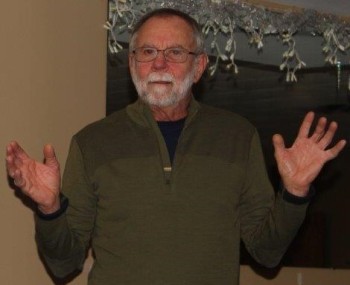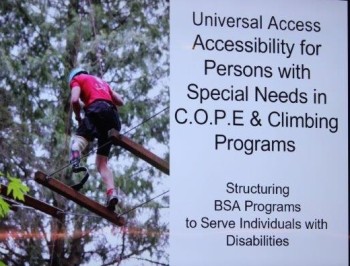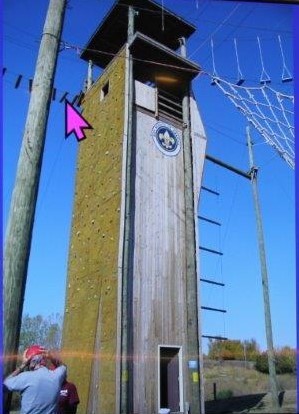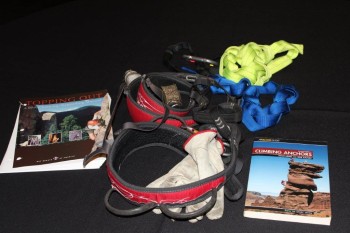The "Manhattan Optimist Club Bulletin": Vol. 2024 #14: 1-3-24
VOLUME 2024 JANURARY 3, 2024 NUMBER 14
President Bill Wisdom welcomed the membership and guests, presented a reflection, followed by the Flag Salute.
Program

Safety is the most important item in these programs. Anytime a scout is sent climbing or rappelling, they perform a CHECK.
Project COPE/Climbing Safety CHECK.
- Clothing: No baggy clothing or loose jewelry; hair is tied up or tucked in.
- Harnesses/Helmets: Properly fitted helmets; ropes properly attached; buckled on harnesses properly secured.
- Environment: Keep all program areas safe, free from hazards, obstructions and monitor weather conditions.
- Connections: Check and double check – make sure anchor points are rigged properly, participants are properly connected, and carabiners are screwed down and locked.
- Knots: check that knots are properly tied, dressed, and backed up with a safety knot.
They also have two spotters; the job of the spotters is to protect a scout’s core, neck, back, and head in case of a fall.
Council vs. Unit Activities
- Council or District activity or on Council property must follow BSA COPE and Climbing/Rappelling National Standards
- Unit activities off of Council property must follow “Climb On Safety” Program.
- More than one unit can participate at the same time and place without it being considered a District function.
- Age-appropriate guidelines must be used.
Climb On Safely
- Qualified supervision
- Qualified instructors
- Physical fitness
- Safe area or safe course
- Equipment
- Planning
- Environmental conditions
- Discipline
They must follow age-appropriate guidelines in activities such as belaying, bouldering, caving, climbing commercial or horizontal walls, climbing rock, climbing a vertical wall or tower, initiative games, lead climbing, Project COPE, rappelling, and snow and ice climbing.
Project C.O.P.E.
- Challenging Outdoor Personal Experience
- Challenge Course/Zip Line(s)
- Low COPE and/or High COPE
- Constructed facilities that may use trees
- 1920-first course; 1981-1st BSA at Geiger
- Eight goals in COPE.
All COPE facilities must be inspected yearly and certified.
Eight Goals of Project C.O.P.E.
- Communication
- Planning
- Teamwork
- Trust
- Leadership
- Decision Making
- Problem Solving
- Self-Esteem
Project C.O.P.E.’S program is composed of the following:
- Group initiative games
- Trust events
- Low-course events and high-course events
- Most activities involve a group challenge
- Some develop individual skills and agility
- Participants climb, swing, balance, jump, rappel
- Devise solutions to a variety of problems
Scouts are 100% tied off when utilizing the climbing tower facilities.
Universal Access and accessibility for persons with special needs in C.O.P.E and climbing programs. BSA structures programs to serve individuals with disabilities.

Climbing/Rappelling Outline
- Terms and definitions
- Rating of Climbs
- Constructed sites
- Criteria in choosing a natural site
- Natural site selection issues
- Equipment required at natural sites
- Anchors
- Rock climbing
Basic Mountaineering Definitions
- Mountaineering is the sport, hobby or profession of walking, hiking, backpacking and climbing mountains.
- Alpine Climbing is Mountaineering in Europe and typically involves some snow, ice, and rock climbing. It includes climbing “light” on supplies and equipment vs. expedition style climbs.
- Rock Climbing is a sport, hobby, or profession where participants climb up or across natural rock formations or man-made rock walls with the goal of reaching the summit or the endpoint of a pre-defined route.
- Rappelling (Abseiling) is typically used to lower ones self from a climb. It has evolved to a separate sport or hobby since the advent of helicopters; military personnel took it up as a sport following military service. It is also used in caving and canyoneering.
Three Basic Categories of Rock Climbing
- Traditional: Also known as “Trad”- Uses removable protection (pro), but also can involve fixed gear that was put up “on lead.”
- Sport: Typically uses permanently fixed protection. Rap bolting (done while on rappel) has become common.
- Free Solo: No protection. Two types of people – crazy and dead.
Technical rock climbing – Equipment used only for protection against falls. Aid Climbing- Equipment holds body weight while climbing.
Yosemite Decimal System
- Easy trail hiking with minimal elevation gain or loss.
- Trail hiking with elevation gain and loss
- Hiking up/down steep slopes that require the use of hands.
- Hiking/Climbing that requires roping up due to fall danger (Glacier travel and scrambling up/down steep grades)
- Technical rock climbing is graded from 5.0 to 5.15c.
- Aid climbing is graded from A1 to A5.
Constructed Facilities in the Coronado Council
- Camp Brown, Abilene, KS: Robert K. Weary Climbing/Rappelling Tower
- Camp Hansen Kirwin, KS: COPE course and Climbing/Rappelling Tower
- Use knowledgeable people, guidebooks, internet. Known as “beta.”
- Use established sites.
- Get permission from owners and/or managers.
- Exposure to sun/shade vs. time of day/season needs to be considered.
- Emergency routes out need to be devised.
- Follow local rules, customs, and regulations.
- Know dangers in area: traffic; dangerous/poisonous animals and poisonous plants.
Suitability of Site Questions
- Accessibility – how easy/safe to get to?
- Safe Zone - is one available?
- Rock Quality – is rock stable; rock fall?
- Graded Climbs – age/skill appropriate?
- Communication – what types will work?
- Anchors – bolts, pro, natural rocks and trees?
- Top Rope or Lead – is lead climber qualified?
- Are climbs friction, crack, edges; or mixed?
- Length of climbs – depends on difficulty?
- Dangerous/Poisonous plants and animals?
- Helmet – May need one for each scout.
- Harness - May need one for each scout.
- Rope – Need ropes for climbing and rappelling
- Personal gear – Boots, food, water, clothing, etc.
- Gloves – Used for rappelling and belaying.
- Belay Devices – ATC, sticht plate, figure 8, etc.
- Safety Lines – Needed at top/bottom of climb.
- Connectors – Slings, carabiners, accessory cord.
- Anchor Systems – Need variety of equipment.
Equipment is very expensive.
Anchor Systems- Top Rope anchors-
- Bottom Belaying Anchors – Are these true anchors?
- Top Belaying Anchors-
- Anchor System Types –
- Redirection of Loading on Anchor Systems –
- Limiting Shock-Loading of Anchors –
- Multi-Pitch Climbing/Intermediate Belays
- SERENE (Solid, Equalized, Redundant, Efficient, No Extension); ERNEST (Equalized, Redundant, No Extension, Strong, Timely) -
Fail–Proof Anchor Systems
- Bomb Proof
- Bomb Proof
- Bomb Proof
- Bomb Proof
If #’s 1-4 cannot be accomplished. Find another place to climb. Safety is the most important issue.
Goals of COPE and Rock Climbing/Rappelling
- Communication
- Planning
- Teamwork
- Trust
- Leadership
- Decision Making
- Problem Solving
- Self-Esteem
- Fun
Don related the story of a young female scout who was halfway up and became frightened and decided she wanted to come down. She came down, Don hi-fived her on her accomplishment of going as high as she did. Ten minutes later she came back and was determined to try it again and she went all the way to the top. When she came down she was elated and very proud of herself. Don, commented, “That is why we do this.”
Guests:
Don Bechtel introduced his good friend, Gerry Snyder, recently retired from working with technology and video at K-State. Greg McCune introduced Jean and Marlo Klassen, then also introduced Brady Armstrong, Chief Development Officer, with the Boy’s and Girl’s Club.
Club Stuff/Announcements:
Lisa Brummett noted unwanted Christmas gifts may make great silent auction items for the Spaghetti Dinner.
Doug Jardine announced the Zone 3 Optimist meeting will be Saturday February 10th in Salina.
Bill Wisdom reminded everyone that Roger Maughmer, who died on December 29th, is Saturday at 2:00 PM at Yorgensen-Meloan-Londeen funeral home. Roger was a member from 1978-2005.
Bill also announced the member Birthdays for January. January Birthday Link.
Save these dates: March 15 & 16: State Special Olympics Basketball and March 23rd for the annual Spaghetti Dinner.
Adjourned with the Optimist Creed
Next Weeks’s Meeting:
JANUARY 10 – NOON MEETING: Program: Bethany Fields, Riley County Deputy Attorney: Topic: Prosecutor of the Year Award Winner
JANUARY 17 – MORNING MEETING: Program: Youth of the Month Presentations: Ogden & Oliver Brown Elementary Schools




